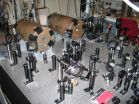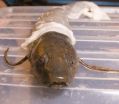(Press-News.org) Do you like to do good things for other people? If so, your genes might be responsible for this. At least, the results of a study conducted by researchers of the University of Bonn suggest this. According to the study, a minute change in a particular gene is associated with a significantly higher willingness to donate. People with this change gave twice as much money on average to a charitable cause as did other study subjects. The results have now been published in the journal Social Cognitive & Affective Neuroscience (doi: 10.1093/scan/nsq083).
The researchers working with the psychologist Professor Dr. Martin Reuter invited their students to take a "retention test": The roughly 100 participants were to memorize series of numbers and then repeat them as correctly as possible. They received the sum of five Euros for doing this. Afterwards, they could either take their hard-earned money home or donate any portion of it to a charitable cause. This decision was made freely and in apparent anonymity. "However, we always knew how much money was in the cash box beforehand and could therefore calculate the amount donated", explains Reuter.
The scientists had asked their study subjects to undergo a cheek swab beforehand. They were able to extract DNA for genetic analyses from the cells thus sampled. In these analyses, they focused on one gene, the so-called COMT gene. It contains the building instructions for an enzyme which inactivates certain messengers in the brain. The most well-known of these messengers is dopamine.
It has been known for nearly 15 years that there are two different variants of the COMT gene: COMT-Val and COMT-Met. Both versions, which occur in the population with approximately equal frequency, differ in only a single building block. In the case of people with the COMT-Val variant, the associated enzyme works up to four times more effectively. Thus considerably more dopamine is inactivated in the brain of a person with this variant.
Mini-Mutation Affects Behavior
This mini-mutation also has effects on behavior: "Students with the COMT-Val gene donated twice as much money on average as did fellow students with the COMT-Met variant", explains Reuter. This is the first time that researchers have been able to establish a connection between a particular gene and altruistic deeds. However, it was already known from studies on twins that altruistic behavior is also partly influenced by our genes.
There is a good reason why the Bonn scientists focused their analysis on the COMT gene: For several years, it has been known that dopamine is involved in controlling social behavior in animals and humans. Thus the messenger, together with substances such as the neuropeptide vasopressin, influences sexuality and bonding. In addition, dopamine is linked with positive emotionality. Even the characteristic of being motivated by stimuli is controlled by this important neurotransmitter.
INFORMATION:
Contact information:
Professor Dr. Martin Reuter
Institute for Psychology and Center for Economics and Neurosciences
University of Bonn
Tel.: 0228/73-8284
E-Mail: martin.reuter@uni-bonn-diff.de
Researchers in Bonn find an 'altruism gene'
A difference in a single gene is associated with a significantly increased willingness to donate
2010-11-09
ELSE PRESS RELEASES FROM THIS DATE:
Quantum memory for communication networks of the future
2010-11-09
Researchers from the Niels Bohr Institute at the University of Copenhagen have succeeded in storing quantum information using two 'entangled' light beams. Quantum memory or information storage is a necessary element of future quantum communication networks. The new findings are published in Nature Physics.
Quantum networks will be able to protect the security of information better than the current conventional communication networks. The cornerstone of quantum communication is a phenomenon called entanglement between two quantum systems, for example, two light beams. ...
Graphene gets a Teflon makeover
2010-11-09
Professor Andre Geim, who along with his colleague Professor Kostya Novoselov won the 2010 Nobel Prize for graphene – the world's thinnest material, has now modified it to make fluorographene – a one-molecule-thick material chemically similar to Teflon.
Fluorographene is fully-fluorinated graphene and is basically a two-dimensional version of Teflon, showing similar properties including chemical inertness and thermal stability.
The results are this week reported in the advanced online issue of the journal Small. The work is a large international effort and involved ...
Were our tetrapod ancestors deaf?
2010-11-09
Many changes in the sensory systems of tetrapods are associated with the water-to-land transition. In hearing, one of the crucial elements in detecting airborne sound is the tympanic ear. Surprisingly, the tympanic ear originated independently in the major tetrapod lineages and relatively late after the terrestrial tetrapods emerged – in the Triassic, more than 100 million years after the origin of tetrapods. The major question raised by the researchers Jakob Christensen-Dalsgaard, Christian Brandt and Magnus Wahlberg, University of Southern Denmark, and Maria Wilson and ...
Privacy safeguards in Canadian military insufficient: Updated rules needed
2010-11-09
Privacy legislation and protocols to safeguard the health information of members of the military are lacking, and the head of Canada's military must take action to ensure health privacy for all staff, states an editorial in the Canadian Medical Association Journal (CAMJ) http://www.cmaj.ca/cgi/doi/10.1503/cmaj.101630.
Recent violations at Veterans Affairs Canada of privacy regarding sensitive health information raise questions about the military's ability to protect personal health information.
"Few of the world's armed forces provide complete confidentiality of personal ...
Mild painkillers in pregnancy are associated with an increased risk of male reproductive problems
2010-11-09
New evidence has emerged that the use of mild painkillers such as paracetamol, aspirin and ibuprofen, may be part of the reason for the increase in male reproductive disorders in recent decades. Research published in Europe's leading reproductive medicine journal Human Reproduction today (Monday 8 November) shows that women who took a combination of more than one mild analgesic during pregnancy, or who took the painkillers during the second trimester of pregnancy, had an increased risk of giving birth to sons with undescended testicles (cryptorchidism) – a condition that ...
Scientists pinpoint key defense against parasite infection
2010-11-09
Scientists have made a significant discovery about how the body defends itself against snail fever, a parasitic worm infection common in developing countries.
Researchers studied the immune response in mice infected with snail fever parasites. They found that a particular type of immune cell, known as the dendritic cell, is responsible for triggering the immune system's defence against the invading parasite.
The development, by scientists at the University of Edinburgh, could point towards new avenues of research into treatments for the condition, which causes long-term ...
Study examines risk of heterosexual HIV transmission in China
2010-11-09
A new study by researchers at the Johns Hopkins Bloomberg School of Public Health examines the burden of HIV and sexually transmitted disease among male clients of the commercial sex industry in China's Sichuan province. Since 2007, heterosexual transmission has replaced injecting drug use as the primary transmission mode of all HIV infections in China. The study is available online in advance of publication in the journal Sexually Transmitted Infections.
"We found a large burden of syphilis infection coupled with high-risk sexual and substance use behaviors among male ...
Scientist chronicle nanoparticles' journey from the lungs into the body
2010-11-09
BOSTON – Using a novel, real-time imaging system, scientists have tracked a group of near-infrared fluorescent nanoparticles from the airspaces of the lungs, into the body and out again, providing a description of the characteristics and behavior of these minute particles which could be used in developing therapeutic agents to treat pulmonary disease, as well as offering a greater understanding of the health effects of air pollution.
Led by investigators at Beth Israel Deaconess Medical Center (BIDMC) and the Harvard School of Public Health, the findings are described ...
Climate change: Water reservoir glacier
2010-11-09
Glaciers of large mountain regions contribute, to some extent considerably, to the water supply of certain populated areas. However, in a recent study conducted by Innsbruck glaciologists and climatologists it has been shown that there are important regional differences. The results of the study are published in the scientific journal Proceedings of the National Academy of Sciences (PNAS).
In their recently published study the glaciologists and climatologists, headed by Prof. Georg Kaser and Dr. Ben Marzeion from the Institute of Geography of the University of Innsbruck, ...
Close up on hidden galaxies with new cosmic zoom lenses
2010-11-09
Astronomers have discovered a new way of locating a natural phenomenon that acts like a zoom lens and allows astronomers to peer at galaxies in the distant and early Universe. These results are from the very first data taken as part of the "Herschel-ATLAS" project, the largest imaging survey conducted so far with the European Space Agency's Herschel Space Observatory, and are published today (November 4 2010) in the prestigious scientific journal Science.
The magnification allows astronomers to see galaxies otherwise hidden from us when the Universe was only a few billion ...
LAST 30 PRESS RELEASES:
New critique prompts correction of high-profile Yellowstone aspen study, highlighting challenges in measuring ecosystem response to wolf reintroduction
Stroke survivors miss critical treatment, face greater disability due to systemic transfer delays
Delayed stroke care linked to increased disability risk
Long term use of anti-acid drugs may not increase stomach cancer risk
Non-monetary 'honor-based' incentives linked to increased blood donations
Natural ovulation as effective as hormones before IVF embryo transfer
Major clinical trial provides definitive evidence of impacts of steroid treatment on severe brain infection
Low vitamin D levels shown to raise risk of hospitalization with potentially fatal respiratory tract infections by 33%
Diagnoses of major conditions failing to recover since the pandemic
Scientists solve 66 million-year-old mystery of how Earth’s greenhouse age ended
Red light therapy shows promise for protecting football players’ brains
Trees — not grass and other greenery — associated with lower heart disease risk in cities
Chemical Insights scientist receives Achievement Award from the Society of Toxicology
Breakthrough organic crystalline material repairs itself in extreme cold temperatures, unlocking new possibilities for space and deep-sea technologies
Scientists discover novel immune ‘traffic controller’ hijacked by virus
When tropical oceans were oxygen oases
Positive interactions dominate among marine microbes, six-year study reveals
Safeguarding the Winter Olympics-Paralympics against climate change
Most would recommend RSV immunizations for older and pregnant people
Donated blood has a shelf life. A new test tracks how it's aging
Stroke during pregnancy, postpartum associated with more illness, job status later
American Meteorological Society announces new executive director
People with “binge-watching addiction” are more likely to be lonely
Wild potato follows a path to domestication in the American Southwest
General climate advocacy ad campaign received more public engagement compared to more-tailored ad campaign promoting sustainable fashion
Medical LLMs may show real-world potential in identifying individuals with major depressive disorder using WhatsApp voice note recordings
Early translational study supports the role of high-dose inhaled nitric oxide as a potential antimicrobial therapy
AI can predict preemies’ path, Stanford Medicine-led study shows
A wild potato that changed the story of agriculture in the American Southwest
Cancer’s super-enhancers may set the map for DNA breaks and repair: A key clue to why tumors become aggressive and genetically unstable
[Press-News.org] Researchers in Bonn find an 'altruism gene'A difference in a single gene is associated with a significantly increased willingness to donate


